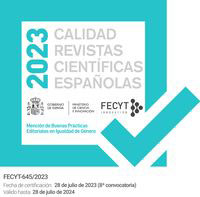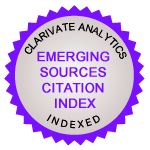Directrices para autores y autoras
Pasado y Memoria establece estas normas que deben cumplir los trabajos enviados a la revista. En caso contrario, los envíos podrán ser rechazados. Para cualquier información o aclaración que se necesite sobre estas instrucciones los autores o autoras pueden dirigirse por correo electrónico a la persona de contacto principal de la revista. Sin embargo, una vez enviado el original, se recomienda a los autores o autoras que utilicen la herramienta de la plataforma denominada, discusiones, para comunicarse con los editores o editoras encargados de gestionar el trabajo.
La revista acepta el envío de artículos de investigación monográficos para la sección “Dosier Monográfico” y de carácter misceláneo para la sección “Estudios”. También admite notas bibliográficas de varios libros o estados de la cuestión de una temática de interés inserta en debates historiográficos vivos y reseñas de libros. El plazo de recepción está abierto durante todo el año.
Además de estas directrices, se recomienda a las autoras y autores la consulta previa, antes de enviar sus originales, de todos los apartados de la revista con información que afectará a los trabajos, como el proceso de evaluación por pares, las políticas éticas de publicación, la política antiplagio, etc.
1 Requisitos
Los requisitos generales que han de tener los trabajos remitidos a la revista son los siguientes:
- Originalidad: la revista solo acepta trabajos que sean originales e inéditos. Esto excluye las traducciones de trabajos ya publicados, en todo o en parte, por cualquier otro medio o en idiomas distintos al del manuscrito remitido a la revista. Tampoco deberán estar en vías de consideración para publicación en otras revistas o editoriales.
- Procedimiento de envío: el trabajo ha de enviarse a través de la plataforma de la revista. Para ello, es necesario Entrar (Iniciar sesión) o Registrarse si no se ha hecho en anteriores ocasiones.
- Idiomas: la revista publica trabajos en español, catalán, inglés, francés, portugués e italiano.
- Autoría: los autores o autoras facilitarán el nombre y apellidos, la filiación institucional o profesional (nombre desarrollado y sin siglas), el país, la dirección de correo electrónico (preferiblemente institucional o profesional) y el identificador ORCID. Para el formato del nombre y apellidos de las personas autoras, se recomienda tener en cuenta la forma de firma para indexación en bases de datos internacionales. Puede consultar la sección “Recomendaciones para la normalización de autores y para las direcciones electrónicas” de la FECYT.
- Anonimización: los trabajos estarán anonimizados (sin marcas que delaten su autoría). En el manuscrito no debe incluirse el nombre de las autoras o autores ni su filiación (será sustituido bajo el rótulo “Autor/a”) y se debe suprimir (bajo el rótulo de *anonimizado*) cualquier otro elemento que pudiera permitir directa o indirectamente la identificación de los autores o autoras en agradecimientos, en proyectos, en fuentes de financiación, instituciones, etc.
- Formato de archivo: los trabajos deben enviarse en un fichero de texto en formato Microsoft Word (.docx) u Open Document Format (.odt).
- Conflicto de intereses: las personas firmantes deberán indicar en el apartado “Comentarios para el editor/a”, cualquier vínculo de orden personal o económico que pueda ser susceptible de influir en las conclusiones de un original, o en caso contrario, declarar que no hay conflicto de intereses.
- Financiación: si el trabajo enviado a la revista proviene de una investigación que ha recibido financiación, se indicará en el apartado “Agencias de apoyo” la entidad financiadora, el código de proyecto, etc. Esta información no deberá aparecer en el archivo enviado para garantizar el anonimato del manuscrito.
2 Artículos de investigación
Los artículos de investigación habrán de ser originales y responder a los estándares científicos de la rama de conocimiento de la Historia Contemporánea.
2.1 Estructura
Todos los manuscritos comenzarán con estos tres elementos:
- Título: debe ser corto (de no más de 25 palabras), informativo (evitando preguntas retóricas), sin acrónimos y debe incluir palabras clave que definan la temática del artículo.
- Resumen: incluirá información sobre los objetivos, la metodología y los principales resultados o conclusiones. Debe ser un solo párrafo y no tener subapartados ni incluir citas. Tendrá una extensión de 200 a 300 palabras.
- Palabras clave: se indicarán un mínimo de 6 términos. Se recomienda que parte de las palabras clave procedan de vocabularios propios de la rama de conocimiento de la Historia Contemporánea o de uso común en ella. Asimismo, deberá incluirse uno o varios topónimos que identifiquen de forma clara el área geográfica objeto de estudio (España, Argentina, Europa meridional, Asturias, Alicante, Iberoamérica, América Latina, Italia, etc.) y el periodo estudiado (siglo XIX, siglo XX, etc.).
Estos tres elementos aparecerán en la lengua original del trabajo y en inglés.
El seguimiento de estas indicaciones facilitará el descubrimiento del artículo en Internet y en las bases de datos.
Se recomienda que el texto de los artículos de investigación se estructure en estos apartados:
- Introducción: debe incluir el marco teórico, los objetivos y la metodología del estudio, utilizando las citas bibliográficas estrictamente necesarias. No incluirá datos o conclusiones del trabajo presentado. No debe realizarse una revisión bibliográfica detallada.
- Desarrollo: la investigación se desarrollará en los capítulos, numerados y titulados, que se considere necesario.
- Conclusiones: resumirán las ideas que se pueden extraer de los resultados y su discusión, de forma clara y concisa.
- Uso de inteligencia artificial: se declarará el uso o no de herramientas de inteligencia artificial en la redacción del texto.
- Bibliografía: mostrará la lista de referencias bibliográficas utilizadas siguiendo las normas de estilo APA.
Los artículos de investigación, que deberán ser inéditos, tendrán una extensión máxima de 9000 palabras con las notas y cuadros inclusive, sin contar la bibliografía, salvo excepciones justificadas, previa autorización del Consejo de Redacción.
2.2 Formato
Deberán estar escritos con letra Times New Roman 12 para el cuerpo y 10 para notas a pie de página, con interlineado sencillo y citas literales largas (de más de 3 líneas) sangradas a la izquierda, entrecomilladas y con letra 11.
2.2.1 Figuras y tablas
Todas las ilustraciones, figuras, gráficos, cuadros y tablas se presentarán colocados en los lugares del texto apropiados y no al final del documento, con título y numerados correlativamente. Solo se utilizarán aquellos que, por su relevancia, sean necesarios para apoyar los argumentos recogidos en el texto. Cada uno de estos objetos deberá aparecer referenciado en el cuerpo del artículo.
Estos elementos tendrán un encabezado con la numeración y el título. Ejemplos:
Tabla 3. Distribución de datos por materia
Figura 7. Representación
Y un pie que indicará la fuente. Ejemplos:
Fuente: elaboración propia
Fuente: Biblioteca Nacional de España
Las imágenes, dibujos, fotografías, figuras, tablas, gráficos, etc. que ilustran los artículos deberán ser obra de los autores o autoras del artículo o, en caso contrario, deberán estar libres de derechos, o bajo licencias Creative Commons que permitan su reutilización e indiquen los usos que pueden hacerse de estos. Si los autores y autoras utilizasen imágenes, gráficos, etc., protegidos por derechos de autor, deberán haber solicitado y obtenido la autorización de los creadores o creadoras de dichas imágenes, gráficos, etc.
3 Notas bibliográficas
Las notas bibliográficas sobre dos o más libros de una misma temática o sobre el estado de la cuestión de un tema referido al período contemporáneo, inserto en un debate historiográfico vivo, tendrán una extensión de entre 3000 y 6000 palabras, acompañándose una bibliografía final según las normas especificadas en el apartado “Citas y referencias”.
La antigüedad máxima de los libros será de dos años.
Se indicarán, al menos, tres palabras clave.
4 Reseñas de libros
Las reseñas serán de libros publicado en los dos últimos años y tendrán una extensión máxima de 1500 palabras.
En el apartado de resumen se indicará la autoría del libro, la editorial, el lugar de publicación y el ISBN. Y en apartado de palabras clave se aportarán un mínimo de tres términos.
5 Citas y referencias
Los trabajos enviados adaptarán las citas y referencias bibliográficas a las normas de la 7.ª edición del manual de estilo de la American Psychological Association (APA). También puede consultar la guía APA (PDF) de la Biblioteca de la Universidad de Alicante.
5.1 Citas en el cuerpo de texto
Cita en el texto de una obra con autor/a o autores/as:
Se introduce la cita resumida entre paréntesis con el apellido(s) del autor/a, seguido por el año de publicación.
Ejemplos:
(Fraser, 2006)
(Molinero et al., 2016)
(Fernández Sebastián, 2004; Fuentes Aragonés, 2005; Koselleck, 1993)
(Hobsbawm, 2002a; 2002b; 2002c)
Cuando además la cita es literal, se incluye el número de página o localización específica de la frase en el texto original.
Ejemplos:
- …este planteamiento supuso un hito historiográfico (Pérez Ledesma, 2006: 117-122)
- Sin embargo, en su estudio sobre el afrancesamiento, Artola (1953: 78) puso en cuestión…
Respecto a la cita en el texto de una obra con dos o tres autores/as: siempre se cita a los autores/as separados por punto y coma. Cuando se citan más de tres autores/as para una obra poner el primer/a autor/a seguido de et al.
Ejemplos:
(Rújula; Butrón, 2000)
(Aymes et al., 2008)
5.2 Referencias bibliográficas
El apartado se titulará «Bibliografía» y aparecerá al final del artículo después de las conclusiones del trabajo. Contendrá únicamente las fuentes que sustentan la investigación y que, por tanto, se han usado para la preparación del trabajo.
Las referencias deben aparecer por orden alfabético del apellido del autor/a (o primer/a autor/a).
Las obras de un mismo autor/a se ordenan cronológicamente apareciendo primero las más antiguas. Primero aparecerán las referencias del autor/a en solitario y en segundo lugar las obras con otros/as autores/as. Cuando haya varias obras del mismo autor/a se repetirá el nombre para cada entrada.
Los títulos de revistas o libros se ponen en cursiva. En el caso de revistas, el número del volumen también irá en cursiva para que quede diferenciado de las páginas (que irán seguidas y sin cursiva y sin necesidad de añadir p. o pp.).
5.2.1 Identificador de objeto digital
Las referencias bibliográficas que tengan un DOI (Digital Object Identifier) lo añadirán al final con formato de enlace, URL completa y segura, sin prefijos ni punto final. El DOI sustituirá a cualquier dirección web en una referencia.
Se puede comprobar el DOI de una lista de referencias en la página Simple Text Query de Crossref.
5.2.2 Ejemplos
A continuación, se muestran algunos ejemplos:
- Libro impreso:
Álvarez Junco, José. (2001). Mater dolorosa. La idea de España en el siglo XIX. Madrid: Taurus.
- Libro versión electrónica con DOI:
Gullickdon, Gay L. (1996). Unruly women of Paris: images of the commune. New York: Cornell University Press. https://doi.org/10.7591/9781501725296
- Libro versión electrónica sin DOI:
Pérez Alonso, Jorge. (2013). Tres controvertidas elecciones presidenciales estadounidenses: Thomas Jefferson, Rutherford B. Hayes y George W. Bush. Oviedo: In Itinere. https://www.unioviedo.es/constitucional/seminario/books/In_Itinere_03-Tres%20presidentes.pdf
- Libro impreso con compilador/a, editor/a, director/a o coordinador/a/es:
Caballero, José Antonio, Delgado Idarreta, José Miguel, Viguera, Rebeca (Eds.). (2015). El lenguaje político y retórico de las constituciones españolas. Proyectos ideológicos e impacto mediático en el siglo XIX. Oviedo: In Itinere.
- Capítulo de libro impreso:
Aresti, Nerea. (2015). Cuestión de dignidad. Género, feminismo y culturas políticas. En Carlos Forcadell; Manuel Suárez Cortina (coords.). La Restauración y la República, 1874-1936, vol. III Historia de las culturas políticas en España y América Latina (pp. 85-110). Madrid-Zaragoza: Marcial Pons-PUZ.
- Artículo de una revista impresa:
Malandain, Gilles. (2015). Blasphème politique et “religión royales” sous la Restauration (France, 1814-1830). Pasado y Memoria, 14, 37-55.
- Artículo de una revista digital con DOI:
Malandain, Gilles. (2015). Blasphème politique et “religión royales” sous la Restauration (France, 1814-1830). Pasado y Memoria, 14, 37-55. https://doi.org/10.14198/PASADO2015.14.02
- Artículo de una revista digital sin DOI:
Florentino, Daniele. (2015). Re-building the Nation-State: The American Civil War in a Transnational Perspective. Hispania Nova, 13, 201-217. https://e-revistas.uc3m.es/index.php/HISPNOV/article/view/2387





